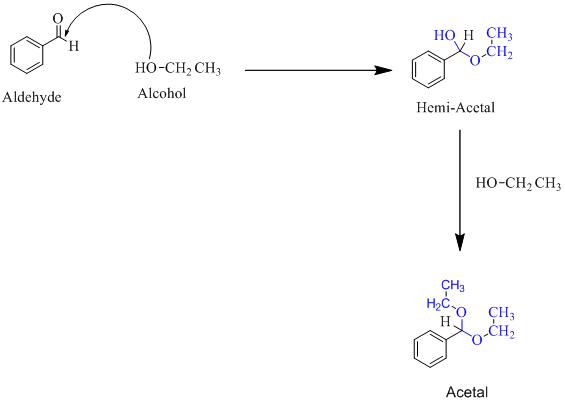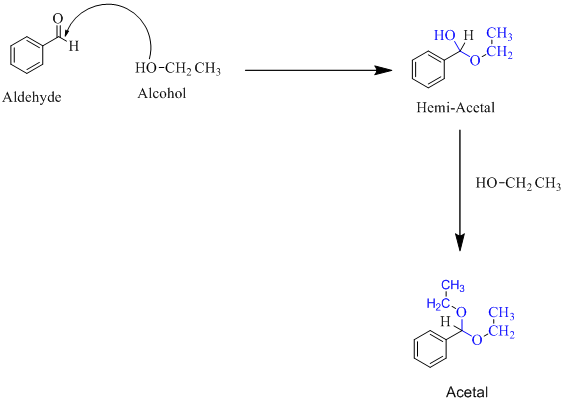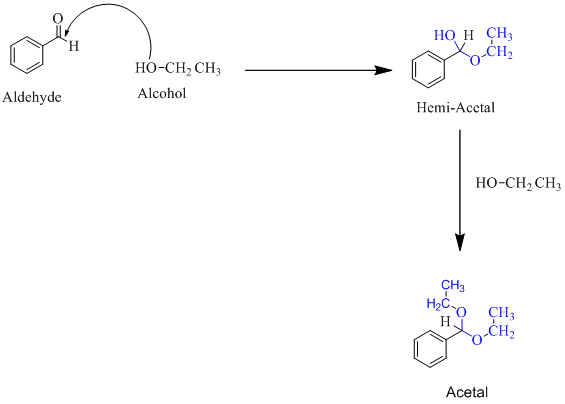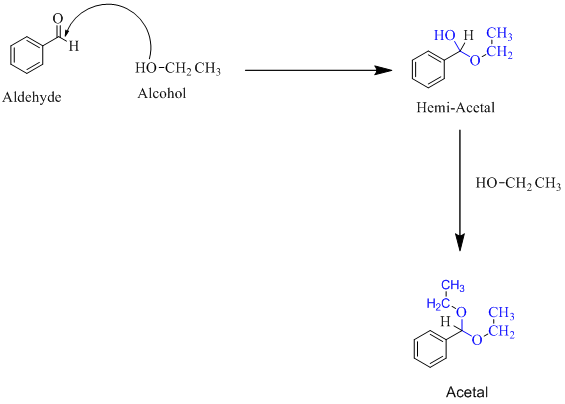
(a)
Interpretation:
To classify the above given compounds in hemi-acetal, acetal and neither.
Concept Introduction:
Hemiacetal is a type of molecule which contains a carbon bonded to one -OH group and one -OR group. It is basically a half acetal. A hemiacetal forms when one molecule of alcohol reacts with a carbonyl group of an
For an Example:

(b)
Interpretation:
To classify the above given compounds in hemi-acetal, acetal and others.
Concept Introduction:
Hemiacetal is a type of molecule which contains a carbon bonded to one -OH group and one -OR group. It is basically a half acetal. A hemiacetal forms when one molecule of alcohol reacts with a carbonyl group of an aldehyde or ketone. An acetal is the type of molecule where two −OR group is attached to a single carbon. An acetal forms when a hemi-acetal reacts with an alcohol.
For an Example:

(c)
Interpretation:
To classify the above given compounds in hemi-acetal, acetal and others.
Concept Introduction:
Hemiacetal is a type of molecule which contains a carbon bonded to one -OH group and one -OR group. It is basically a half acetal. A hemiacetal forms when one molecule of alcohol reacts with a carbonyl group of an aldehyde or ketone. An acetal is the type of molecule where two −OR group is attached to a single carbon. An acetal forms when a hemi-acetal reacts with an alcohol.
For an Example:

(d)
Interpretation:
To classify the above given compounds in hemi-acetal, acetal and others.
Concept Introduction:
Hemiacetal is a type of molecule which contains a carbon bonded to one -OH group and one -OR group. It is basically a half acetal. A hemiacetal forms when one molecule of alcohol reacts with a carbonyl group of an aldehyde or ketone. An acetal is the type of molecule where two −OR group is attached to a single carbon. An acetal forms when a hemi-acetal reacts with an alcohol.
For an Example:

(e)
Interpretation:
To classify the above given compounds in hemi-acetal, acetal and others.
Concept Introduction:
Hemiacetal is a type of molecule which contains a carbon bonded to one -OH group and one -OR group. It is basically a half acetal. A hemiacetal forms when one molecule of alcohol reacts with a carbonyl group of an aldehyde or ketone. An acetal is the type of molecule where two −OR group is attached to a single carbon. An acetal forms when a hemi-acetal reacts with an alcohol.
For an Example:

(f)
Interpretation:
To classify the above given compounds in hemi-acetal, acetal and others.
Concept Introduction:
Hemiacetal is a type of molecule which contains a carbon bonded to one -OH group and one -OR group. It is basically a half acetal. A hemiacetal forms when one molecule of alcohol reacts with a carbonyl group of an aldehyde or ketone. An acetal is the type of molecule where two −OR group is attached to a single carbon. An acetal forms when a hemi-acetal reacts with an alcohol.
For an Example:

Trending nowThis is a popular solution!

Chapter 16 Solutions
Introduction to General, Organic and Biochemistry
- V Biological Macromolecules Drawing the Haworth projection of an aldose from its Fischer projection Draw a Haworth projection of a common cyclic form of this monosaccharide: H C=O HO H HO H H OH CH₂OH Explanation Check Click and drag to start drawing a structure. Xarrow_forwardComplete the mechanismarrow_forwardComplete the mechanismarrow_forward
- 8 00 6 = 10 10 Decide whether each of the molecules in the table below is stable, in the exact form in which it is drawn, at pH = 11. If you decide at least one molecule is not stable, then redraw one of the unstable molecules in its stable form below the table. (If more than unstable, you can pick any of them to redraw.) Check OH stable HO stable Ounstable unstable O OH stable unstable OH 80 F6 F5 stable Ounstable X Save For Later Sub 2025 McGraw Hill LLC. All Rights Reserved. Terms of Use | Privacy C ཀྭ་ A F7 매 F8 F9 4 F10arrow_forwardJust try completing it and it should be straightforward according to the professor and TAs.arrow_forwardThe grading is not on correctness, so if you can just get to the correct answers without perfectionism that would be great. They care about the steps and reasoning and that you did something. I asked for an extension, but was denied the extension.arrow_forward
 Introduction to General, Organic and BiochemistryChemistryISBN:9781285869759Author:Frederick A. Bettelheim, William H. Brown, Mary K. Campbell, Shawn O. Farrell, Omar TorresPublisher:Cengage Learning
Introduction to General, Organic and BiochemistryChemistryISBN:9781285869759Author:Frederick A. Bettelheim, William H. Brown, Mary K. Campbell, Shawn O. Farrell, Omar TorresPublisher:Cengage Learning General, Organic, and Biological ChemistryChemistryISBN:9781285853918Author:H. Stephen StokerPublisher:Cengage Learning
General, Organic, and Biological ChemistryChemistryISBN:9781285853918Author:H. Stephen StokerPublisher:Cengage Learning Organic And Biological ChemistryChemistryISBN:9781305081079Author:STOKER, H. Stephen (howard Stephen)Publisher:Cengage Learning,
Organic And Biological ChemistryChemistryISBN:9781305081079Author:STOKER, H. Stephen (howard Stephen)Publisher:Cengage Learning, Chemistry for Today: General, Organic, and Bioche...ChemistryISBN:9781305960060Author:Spencer L. Seager, Michael R. Slabaugh, Maren S. HansenPublisher:Cengage Learning
Chemistry for Today: General, Organic, and Bioche...ChemistryISBN:9781305960060Author:Spencer L. Seager, Michael R. Slabaugh, Maren S. HansenPublisher:Cengage Learning Organic Chemistry: A Guided InquiryChemistryISBN:9780618974122Author:Andrei StraumanisPublisher:Cengage Learning
Organic Chemistry: A Guided InquiryChemistryISBN:9780618974122Author:Andrei StraumanisPublisher:Cengage Learning




